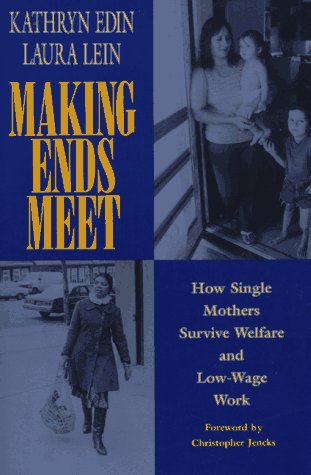During the early 1980’s, social scientists noticed that welfare mothers were spending three to six times their official income. According to Harvard sociologist Christopher Jencks in his foreword to Making Ends Meet, conservatives and liberals have been loath to admit this: conservatives because they refuse to admit that mothers cannot survive on welfare alone, and liberals because they refuse to concede that those on welfare often have unreported income. Extending research begun in the mid-1980’s, Making Ends Meet tries to pinpoint the sources of this income.
Aided by over 30 research associates, sociologist Kathryn Edin and anthropologist Laura Lein interviewed 214 single welfare mothers and 165 poor, working single mothers in Chicago, Boston, San Antonio, and Charleston. The authors seek to undermine welfare reform by offering a rationale for congressional and “nonprofit” forces looking to cushion the shocks welfare mothers will feel upon entering the world of work.
Most of the mothers interviewed derived their income from boyfriends, their children’s fathers, relatives, off-the-books jobs (e.g., babysitting), selling stolen goods, prostitution, or drug dealing. Despite the unreported income, these uneducated, unskilled women—whether on welfare or working at “dead-end” jobs—were barely treading water. The authors report that single working mothers now have more cash but suffer greater material hardship than their nonworking counterparts. Working mothers must pay for additional transportation and medical and childcare that welfare mothers receive free.
Edin and Lein thus conclude that poor women are worse off working than being on welfare. To my knowledge, the authors’ data are generally sound, though most of their “discoveries” are old hat to the over 50 million Americans who have lived in, worked in, or regularly visited slums. Edin and Lein tend to exaggerate the difficulty of finding affordable childcare and adequate transportation. Although a respondent told of getting babysitting services from a welfare mother for a bag or two of groceries per month, the authors invoke a mythical, “market-rate” childcare. As New York University political scientist Lawrence M. Mead noted in The New Politics of Poverty (1992), and as Jencks corroborates, poor working mothers are able to negotiate affordable, unlicensed childcare without inflationary government “service-providers.” The supposed lack of childcare is a rehearsed answer that mothers give to reassure the white, suburban “Suzy the social worker” types: “I really want to work, but . . . “
Edin and Lein alternate between the role of “Suzies” and that of dogged interviewers. They reinterview respondents who initially gave unrealistic budgets, or ambiguous or misleading answers about receiving child support or engaging in prostitution. The pervasiveness of such prostitution matches my own observations in New York; that of unreported child support surprised me. However, when it comes to the mothers’ rationalizations for not working, it’s Suzy time again. On the one hand, the authors emphasize the mothers’ concern for avoiding criminal activity; on the other, they chronicle the mothers’ involvement in prostitution and other crimes.
The authors’ commissions and omissions derive from their loyalties. Edin and Lein gained access to their respondents only through the intercession of “community groups” with a vested interest in the normalization of failure. Considering their fealty to such groups, the authors’ findings are remarkably credible. Yet loyalty precludes Edin and Lein from explaining why so many children grow up fatherless, poor, and dependent. As Fred Siegel and Jim Sleeper have recalled, during the 1960’s the Marxist National Welfare Rights Organization sought to bankrupt New York and precipitate a revolution to be fought by the new proletariat of black welfare clients. Liberal Republican Mayor John V. Lindsay’s Marxist social services commissioner, Mitchell “Come and Get It” Ginsberg, deliberately expanded the welfare rolls from 538,000 to 1.65 million recipients between 1966 and 1971—an action that precipitated not revolution but moral collapse among the city’s poor.
Edin and Lein implicitly define a family as an unwed mother and child(ren), yet are shocked to see such “families” mired in poverty’. Unquestioningly accepting the feminist wisdom about a woman needing a man as a fish needs a bicycle, the authors’ response to welfare’s crushing consequences for poor women is yet more socialism. Men are fatally flawed, yet the state is somehow perfect. A similar myopia causes the authors to confuse cause and effect. It is life in “some of the country’s most dangerous neighborhoods” that drives concerned mothers to opt for the dole over leaving their children unsupervised while they work. But in Why Nothing Works (1987), Marvin Harris observed that welfare mothers’ sons help support their mothers and girlfriends through drug dealing, muggings, and burglaries. Harris explained that welfare clients raised their sons to be violent, the better to protect them from other clients’ sons. Hence, poor young black and Hispanic men—and increasingly women —embrace crime in response not to white racism or lack of opportunity but to their rearing.
Life on the dole is miserable. However, the authors ignore the role of government programs in inflating the cost of living, further reducing the buying power of the working poor and encouraging those who refuse to work. Edin and Lein have targeted readers blissfully unaware of the tens of millions of American families who escape poverty’ through limiting their wants, working extra hours or two jobs, and sharing responsibilities. The authors, who see in welfare reform merely the desire to “punish” unwed mothers, are blind to the connection between welfare clients and the rise in violent crime and in drug and child abuse. The solution is marriage.
[Making Ends Meet: How Single Mothers Survive Welfare and Low-Wage Work, by Kathryn Edin and Laura Lein (New York: Russell Sage Foundation) 320 pp., $42.50]

Leave a Reply